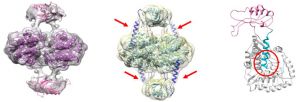“Este trabajo muestra por primera vez la estructura de la enzima TH, que funciona como un tetrámero, es decir, que consta de cuatro partes. Además, se ha observado el mecanismo de autorregulación de TH mediado por la dopamina”, indica Valpuesta. El investigador explica que “en esta estructura se observa una masa central que se corresponde con un tetrámero donde se encuentran los dominios catalíticos, conectada a dos pequeños volúmenes a ambos lados que contienen los dominios reguladores. La unión entre ambas se realiza a través de una región muy flexible en el extremo inicial de TH, lo que explica la dificultad previa de obtener la estructura completa”.
Esta región tan flexible es fundamental en la estricta regulación de la enzima. Jorge Cuéllar, investigador en el CNB-CSIC, destaca: “gracias a la estructura general identificada ahora, se puede entender cómo la TH se autoinhibe en presencia de dopamina”. Combinando la criomicroscopía electrónica con métodos bioquímicos, se ha determinado que la actividad de TH depende de la localización de esta región en la estructura global. Cuando en la célula hay suficiente cantidad de dopamina, esta se une al centro activo de la TH, la región flexible se mueve para proteger esta unión y se mantiene la inhibición. Por el contrario, ante una nueva necesidad de dopamina, se activa la fosforilación de la región flexible, que desestabiliza la unión de la enzima y la dopamina, siendo desplazada del centro activo, y la enzima vuelve a funcionar. “El nuevo modelo permite seguir los cambios en la estructura tridimensional de la enzima al unirse con la dopamina y el papel relevante de la región flexible en el funcionamiento o la inhibición de su acción”, recalca Cuéllar.
Tirosina hidroxilasa, clave en enfermedades neurológicas
La producción de neurotransmisores como la dopamina y adrenalina son procesos muy regulados por la importancia de su acción sobre el control motor, la emoción, la recompensa, los biorritmos y el aprendizaje. La tirosina hidroxilasa (TH) es una enzima clave en el metabolismo de estas sustancias y cataliza el paso limitante en su producción. El mal funcionamiento de la enzima puede producir diversas enfermedades neurológicas entre las que se encuentra la enfermedad de Parkinson.
Más información
MT Bueno-Carrasco, J Cuéllar, MI Flydal, C Santiago, A Kråkenes, R Kleppe, J. López-Blanco, M Marcilla, K Teigen, S Alvira, P Chacón, A Martinez, JM Valpuesta. Structural mechanism for tyrosine hydroxylase inhibition by dopamine and reactivation by Ser40 phosphorylation. Nature Communications 2022 DOI: https://doi.org/10.1038/s41467-021-27657-y






